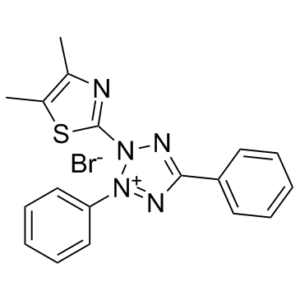This product is for research use only, not for human use. We do not sell to patients.

| Size | Price | Stock |
|---|---|---|
| 1g | $55 | 3-6 Days |
| 2g | $85 | 3-6 Days |
| 5g | $125 | 3-6 Days |
| 10g | $190 | 3-6 Days |
Cat #: V4384 CAS #: 298-93-1 Purity ≥ 98%
Description: MTT (Thiazolyl Blue; Tetrazolium Bromide; Methylthiazolyldiphenyl-tetrazolium bromide), a colorimetric agent, is a cell-permeable and positively charged tetrazolium dye that is widely used to measure cell proliferation. Its mechanism of action is to detect reductive metabolism in cells. MTT is reduced from yellow color to purple formazan in living cells. MTT is used in conjunction with rhodamine B to measure mitochondrial membrane potential. MTT-formazan is generated in mitochondria acts as a fluorescence quencher for rhodamine that distributes across membranes of viable cells according to membrane potential. In the absence of mPMS, cellular reduction of MTT is strong. MTT is membrane-impermeable when incorporated into large unilamellar liposomes, and therefore it is taken up by cells via endocytosis. However, it can be taken up by cells in the free form through the plasma membrane and then reduced to formazan by intracellular NAD(P)H-oxidoreductases. It is frequently used in colorimetric assays to measure cell proliferation, cytotoxicity, and apoptosis.
Publications Citing InvivoChem Products
Product Promise

- Physicochemical and Storage Information
- Protocol
- Related Biological Data
- Stock Solution Preparation
- Quality Control Documentation
| Molecular Formula | C₁₈H₁₆BrN₅S |
|---|---|
| CAS No. | 298-93-1 |
| Storage | -20℃ for 3 years in powder form |
| -80℃ for 2 years in solvent |
| Protocol | In Vitro | MTT is used in conjunction with rhodamine B to measure mitochondrial membrane potential. MTT-formazan is generated in mitochondria acts as a fluorescence quencher for rhodamine that distributes across membranes of viable cells according to membrane potential. In the absence of mPMS, cellular reduction of MTT is strong. MTT is membrane-impermeable when incorporated into large unilamellar liposomes, and therefore it is taken up by cells via endocytosis[1]. |
|---|
This equation is commonly abbreviated as: C1 V1 = C2 V2
- (1) Please be sure that the solution is clear before the addition of next solvent. Dissolution methods like vortex, ultrasound or warming and heat may be used to aid dissolving.
- (2) Be sure to add the solvent(s) in order.




































